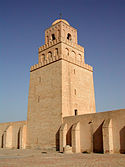| Revision as of 08:17, 10 August 2016 editRussBot (talk | contribs)Bots1,407,994 editsm Bot: Change redirected category Arabs to Arab people← Previous edit | Revision as of 14:00, 10 August 2016 edit undo105.156.234.95 (talk) overcat,arab scholars and medieval arab people are more specificTag: Visual editNext edit → | ||
| Line 60: | Line 60: | ||
| ] | ] | ||
| ] | ] | ||
| ] | |||
| ] | |||
| ] | ] | ||
Revision as of 14:00, 10 August 2016
| This article needs additional citations for verification. Please help improve this article by adding citations to reliable sources. Unsourced material may be challenged and removed. Find sources: "Sahnun" – news · newspapers · books · scholar · JSTOR (August 2010) (Learn how and when to remove this message) |
| Sahnun | |
|---|---|
| Title | Sahnun |
| Personal life | |
| Born | 776–7 CE (160 AH) |
| Died | 854–5 CE (240 AH) |
| Era | Islamic golden age |
| Main interest(s) | Hadith and Fiqh |
| Notable work(s) | Al-Mudawwana |
| Religious life | |
| Denomination | Sunni Islam |
| Jurisprudence | Maliki |
Sahnun ibn Sa'id ibn Habib at-Tanukhi (c. 776-7 – 854-5) (160 AH – 240 AH ) was a jurist in the Maliki school from Qayrawan in modern-day Tunisia.
Biography
His original name was Mohammed Ibn Said Ibn Habib. He gained the nickname 'Sahnun' (a type of sharp bird) because of his quickness of mind. His father was a soldier from Homs in Syria. The family claimed descent from Tanukh, a tribal confederation that originated in the south of the Arabian Peninsula.
Life
In his youth Ibnu Sahnun studied under the scholars of Qayrawan and Tunis. In particular, he learned from the Tripolitanian scholar `Ali bin Ziyad, who had learned from Imam Malik. In 178 AH he traveled to Egypt to study under other pupils of Malik, who died before Sahnun had the financial means to reach them. Later on he continued to Medina and studied under other prominent scholars, returning to North Africa in 191 AH.
At the age of 74 Sahnun was appointed Qadi (judge) of North Africa by the Aghlabid emir Muhammad I Abul-Abbas. He had refused the appointment for a year, only accepting after the emir swore to give him a free hand in matters of justice, even if this involved prosecuting members of the emir's family and court. Upon accepting the appointment, he was said to have told his daughter Khadija, "Today your father has been slain without a knife." He was known to be scrupulous in his judgments and courteous towards litigants and witnesses, but strict towards the men surrounding the emir; he refused to allow them to send representatives on their behalf in litigation, and refused a request from the emir not to interfere in their illegal ventures.
Death
Sahnun died in Rajab of 256 in the Hejira calendar. The men surrounding the emir refused to join his funeral prayer, due to his harshness against them. Yet the emir conducted the funeral prayers in person, and the people of Qayrawan were greatly upset by his passing.
Theological Views
Sahnun was known for his strong orthodoxy, even to the point of refusing to pray behind a Mu'tazilite imam. He excluded heretical sects from the mosque, including the Ibadi, Mu'tazilites and others. The Encyclopedia of Islam states:
Hitherto, in the multiple circles of scholarship, representatives of all tendencies were able to express themselves freely in the Great Mosque of Kairouan. In a process amounting to a purging of the community of scholars there, Sahnun put an end to this "scandal". He dispersed the sects of the ahl al-bida; the leaders of heretical sects were paraded ignominiously, and some were compelled to recant in public. Sahnun was one of the greatest architects of the exclusive supremacy of Sunnism in its Maliki form throughout the Muslim West.
Works
Sahnun's greatest contribution to Muslim scholarship was Al-Mudawwana, a compendium of the legal opinions of the school of Medina as stated by Imam Malik, after the death of the Imam. The compilation and revision process involved four mujtahid imams of the Maliki school: Asad ibn al Furat (d.213 AH); Al-Ashhab (d.204); Ibn al-Qasim (d.191 AH), and Sahnun himself. It is referred to as "al Umm", or "the Mother", of the Maliki school. Sahnun's revision and transmission of the Mudawwana was the major factor in the spread of the Maliki school across the West of the Muslim world.
References
- V. Minorsky, First Encyclopaedia of Islam: 1913-1936, p 64. ISBN 9004097961
- V. Minorsky, First Encyclopaedia of Islam: 1913-1936, p 64. ISBN 9004097961
- V. Minorsky, First Encyclopaedia of Islam: 1913-1936, p 64. ISBN 9004097961
- V. Minorsky, First Encyclopaedia of Islam: 1913-1936, p 64. ISBN 9004097961
- V. Minorsky, First Encyclopaedia of Islam: 1913-1936, p 64. ISBN 9004097961
- V. Minorsky, First Encyclopaedia of Islam: 1913-1936, p 65. ISBN 9004097961
- V. Minorsky, First Encyclopaedia of Islam: 1913-1936, p 65. ISBN 9004097961
- Mohamed Talbi, "Sahnun," Encyclopedia of Islam, 2nd ed., Vol. VIII, pp. 843–845.
